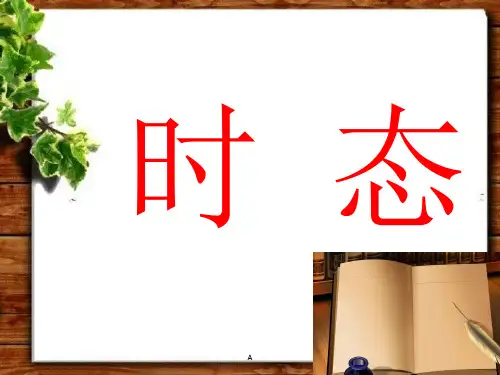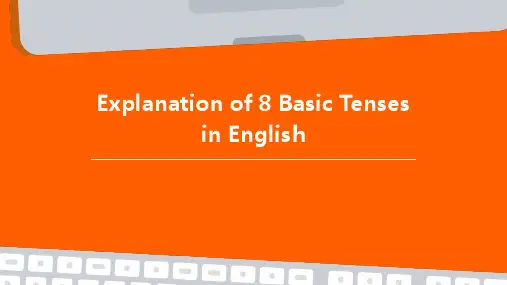高中英语语法八大时态讲解共26页
- 格式:ppt
- 大小:4.03 MB
- 文档页数:26


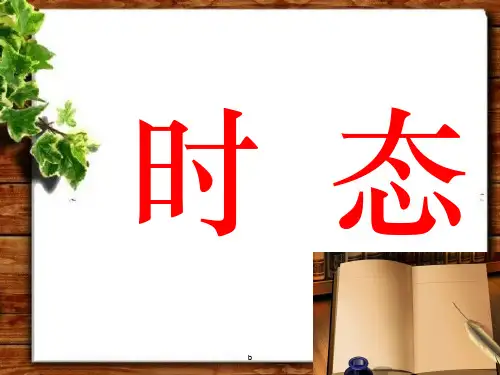
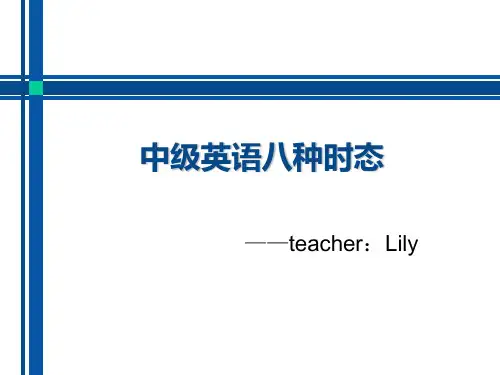



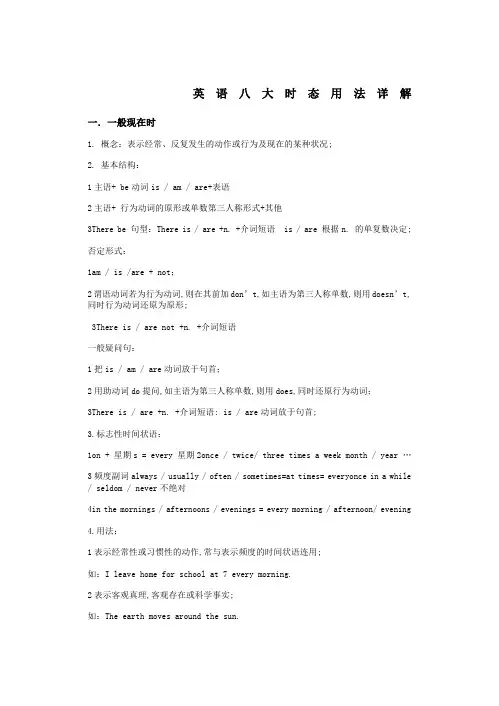
英语八大时态用法详解一.一般现在时1. 概念:表示经常、反复发生的动作或行为及现在的某种状况;2. 基本结构:1主语+ be动词is / am / are+表语2主语+ 行为动词的原形或单数第三人称形式+其他3There be 句型:There is / are +n. +介词短语 is / are 根据n. 的单复数决定;否定形式:1am / is /are + not;2谓语动词若为行为动词,则在其前加don’t,如主语为第三人称单数,则用doesn’t,同时行为动词还原为原形;3There is / are not +n. +介词短语一般疑问句:1把is / am / are动词放于句首;2用助动词do提问,如主语为第三人称单数,则用does,同时还原行为动词;3There is / are +n. +介词短语: is / are动词放于句首;3.标志性时间状语:1on + 星期s = every 星期2once / twice/ three times a week month / year …3频度副词always / usually / often / sometimes=at times= everyonce in a while / seldom / never不绝对4in the mornings / afternoons / evenings = every morning / afternoon/ evening4.用法:1表示经常性或习惯性的动作,常与表示频度的时间状语连用;如:I leave home for school at 7 every morning.2表示客观真理,客观存在或科学事实;如:The earth moves around the sun.3表示格言或警句;如:Pride goes before a fall. 骄者必败;注意:此用法如果出现在宾语从句中,即使主句是过去时,从句谓语也要用一般现在时;如:Columbus proved that the earth is round.4表示现在时刻的状态、能力、性格、个性等;如:I don’t want so much.Ann writes good English but does not speak well.5一般现在时表示将来含义① come, go, arrive, leave, start, begin, return的一般现在时可以表示将来,主要用来表示在时间上已确定或安排好的事情;如:The train leaves at six tomorrow morning.— When does the bus star— It stars in ten minutes.②在时间或条件状语句中;如:When Bill comes 不是will come, ask him to wait for me.I’ll write to you as soon as I arrive there.二.一般过去时1. 概念:表示过去某个时间里发生的动作或状态;过去习惯性、经常性的动作或行为;2. 基本结构:1主语+ was / were +表语2主语+ 行为动词的过去式 +其他3There be 句型:There was / were +n. +介词短语4主语+could+动词原形5主语+used to do sth否定形式:1was / were + not;2在行为动词前加didn’t,同时还原行为动词;3There was / were not +n. +介词短语4主语+could not +动词原形5主语+used not to do sth或主语+didn’t use to do sth一般疑问句:1was或were放于句首;2用助动词do的过去式did 提问,同时还原行为动词;3There was / were +n. +介词短语:was或were放于句首;4could放于句首;5Used主语+ to do sth或Did+主语+use to do sth3.时间状语:1last 短语2时间段+ago 3yesterday及yesterday短语4at the age of = when sb. was+年龄5in one’s teens / twenties6固定短语:just now=a moment ago, one day, from then on, at that time, the day before yesterday, before, long before, in the past , in the / early old days, in the ancient days, in the ancient + 国家,long long ago = once upon a time 故事的开头4. 用法:1在确定的过去时间里所发生的动作或存在的状态;如:Where did you go just now2表示在过去一段时间内,经常性或习惯性的动作;如:When I was a child, I often played football in the street.注意:used to do sth“过去常常做某事”,表示过去习惯性的动作或状态,但如今已不存在;如:Mother used not to be so forgetful. 妈妈过去没这么健忘;3用于时间状语从句a. 由when 引导的时间状语从句,从句用一般过去时态,主句用过去进行时态;如:His mother was cooking when he came back.b. 由since/before 引导的时间状语从句,从句用一般过去时态,主句用现在完成时态;如:I have made many friends since I came to China.It has been/is 15 years since I was a teacher.It has been/is 15 years before he knew it. 不知不觉15 年过去了;c. 由when / by the time/ before引导的时间状语从句,从句用一般过去时态,主句用过去完成时态;如:The plane had taken off when / by the time we arrived at the airport.The Enlish class had begun before I got to school.三.现在进行时1. 概念:表示现阶段或说话时正在进行的动作及行为;2. 基本结构:主语 + am / is /are + doing否定形式:主语 + am / is / are + not + doing一般疑问句:把be动词放于句首;3.时间状语:(1)now 2at this time = at this / the moment 3Look/Look at …4Listen / Listen to …5these days / months / years6It is+ 时间点/日期/星期4. 用法:1表示现在指说话人说话时正在发生的事情;如:We are waiting for you.2表示长期的或重复性的动作,说话时动作未必正在进行;如:Mr Green is writing another novel. 说话时并不一定在写小说3表示动作的渐变,这样的动词有:get, grow, become, turn, run, go, begin等;如:The leaves are turning red.It’s getting warmer and warmer.4与always, constantly, forever 等词连用,表示反复发生的动作或持续存在的状态,往往带有说话人的主观色彩;如:You are always changing your mind. 你老是改变主意;5用现在进行时表示将来下列动词come, go, arrive, leave, start, begin, return等瞬间动词的现在进行时可以表示将来;如:I’m leaving tomorrow.四.过去进行时1. 概念:表示过去某段时间或某一时刻正在发生或进行的行为或动作;如:My brother fell while he was riding his bicycle and hurt himself.2. 基本结构:主语 + was / were + doing否定形式:主语 + was / were + not + doing一般疑问句:把was或were放于句首;3. 时间状语:1at that time2at this time+过去的时间3It was+ 时间点/ 日期/ 星期过去4from A时间 to B时间+过去的时间4. 用法:1过去进行时表示过去某段时间内持续进行的动作或者事情;如:We were watching TV from seven to nine last night.2过去进行时可以表示在过去某个时间点发生的事情;时间点可以用介词短语、副词或从句来表示;如:What was she doing at nine o’clock yesterday 介词短语表示时间点She was doing her homework then. 副词表示时间点When I saw him he was decorating his room. when从句表示时间点3在复合句中,如果主要动作和背景动作都是延续的或同时发生的,那么主从句的动词都可用过去进行时;如:When he was waiting for the bus, he was reading a newspaper. 两个动作都是延续的He was cleaning his car while I was cooking. 两个动作同时进行或主句的动作发生在从句的动作过程中五.一般将来时1. 概念:表示将要发生的动作或存在的状态及打算、计划或准备做某事;2. 基本结构:1主语 + am / is / are / going to do sth2主语 + will do sth3主语 + am / is /are t to do sth 4主语 + am / is /are about to do sth否定形式:1主语 + am / is /are + not + going to do sth2主语 + will notwon’t do sth3主语 + am / is /are not t to do sth 4主语 + am / is /are not about to do sth一般疑问句:1am / is / are放于句首;2will置于句首;3am / is / are放于句首;4am / is / are放于句首;2. 时间状语:1tomorrow及其短语、 the day after tomorrow2next短语3固定短语:one day, someday = some day, in the future, from now / today on, before long, sometime, in +时间段多长时间之后, in following+ 时间段4. will主要用于以下三个方面:1表示主观意愿的将来;如:They will go to visit the factory tomorrow.2表示不以人的意志为转移的客观的将来;如:Today is Saturday. Tomorrow will be Sunday.He will be thirty years old this time next year.3表示临时决定,通常用于对话中;— Mary has been ill for a week.— Oh, I didn’t know. I will go and see her.5. be going to主要用于以下两个方面:1表示事先经过考虑、打算、计划要做某事;如:Dad and I are going to watch an opera this afternoon.今天下午我和爸爸打算去看歌剧;2表示根据目前某种迹象判断,某事非常有可能发生,表示推测;如:Look There come the dark clouds. It is going to rain.6. 用于状语从句由when /as soon as / begore / after 等引导的时间状语从句或者if, unless, as/ so long as 引导的条件状语从句,从句用一般现在时态或从句为祈使句,再或者从句中含有情态动词,主句用一般将来时态;可理解为主将从现、主祈从现、主情从现如:Don’t trouble troubles until trouble troubles you.He will help you out whenever you have problems.I won't go to the partyunlessI'm invited.六.过去将来时1. 概念:立足于过去某一时刻,从过去看将来,常用于宾语从句中;2. 基本结构:1主语 + was / were / going to do sth2主语 + would do sth否定形式:1主语 + was / were / not + going to do sth2主语 + would + not + do sth一般疑问句:1was或were放于句首;2would 提到句首;3. 时间状语:the next day morning, year, the following month week等;4. 用法:1“would + 动词原形”常表示主观意愿的将来;如:He said he would come to see me. 他说他要来看我;2“was / were + going to + 动词原形”常表示按计划或安排即将发生的事;如:She said she was going to start off at once.I was told that he was going to return home.此结构还可表示根据某种迹象来看,很可能或即将发生的事情;如:It seemed as if it was going to rain. 看来好像要下雨;3come,go,leave,arrive,start等瞬时动词可用过去进行时表示过去将来的含义;如:He said the train was leaving at six the next morning.She told me she was coming to see me.七.现在完成时1. 概念:过去发生或已经完成的动作对现在造成的影响或结果,或从过去已经开始持续到现在并且有可能继续下去的动作或状态;3. 基本结构:主语 + have / has + done +其他否定形式:主语 + have / has + not +done +其他一般疑问句:Have / Has +主语 + done +其他4. 时间状语:1already 用于肯定句yet否定句和一般疑问句2just, ever, before, never3so far=up to now = until / till now = by now4over/ in the past /last +时间段5by + 时间6by the end of +现在的时间7since +过去时间如具体的年、月、日、钟点等,如:1980, last month, half past six8 since +一段时间+ ago 9recently = lately10in recent +时间段5. 特殊用法:1由since/before 引导的时间状语从句,从句用一般过去时态,主句用现在完成时态;如:I have made many friends since I came to China.It has been/is 15 years since I was a teacher.It has been/is 15 years before he knew it. 不知不觉15 年过去了;(2)用于由that引导的定语从句中,先行词前有形容词的最高级修饰;如:You’re the best teacher that has ever taught me.6. 比较since和forsince 用来说明动作起始时间,for用来说明动作延续时间的长度;如:We haven’t had any guests since we moved in here.I have lived here for more than twenty years.注意:并非有for 作为时间状语的句子都用现在完成时;I worked here for more than twenty years. 我现在已不在这里工作;7. 延续性动词与非延续性动词之间的转换:leave --- be away from borrow --- keep buy --- have begin/start --- be ondie --- be dead finish --- be over open sth --- keep sth openjoin --- be in+组织机构或be a member of+组织机构fall ill / asleep --- be ill / asleep get up---be upcatch / get a cold --- have a cold come here --- be here go there --- be therebecome / get +adj.--- be+adj come back --- be back get to/ arrive/reach --- be inget to know --- know go get out ---be out put on--- wear/ be in /be dressed in八.过去完成时1. 概念:以过去某个时间为参照,在此以前发生的动作或行为,或在过去某动作之前已完成的动作,即“过去的过去”;2. 基本结构:主语 + had done +其他否定形式:主语 + hadn’t done +其他一般疑问句:had置于句首;3. 时间状语:before, by the end of last yearterm, month等;4. 用法:1用于told, said, knew, heard, thought等动词后的宾语从句中;如:She said that she had never been to Paris.2由when / by the time/ before引导的时间状语从句,从句用一般过去时态,主句用过去完成时态;如:The plane had taken off when / by the time we arrived at the airport.The Enlish class had begun before I got to school.When the police arrived, the thieves had run away.3表示意向的动词,如hope, wish, expect, think, intend, mean, suppose等用过去完成时表示“原本······,未能······”;如:We had hoped that you would come, but you didn’t.注意: had hardly… when ... 刚······就······;如:I had hardly opened the door when he hit me. 我刚打开门,他就打了我; had no sooner…than 刚······就······;如:He had no sooner bought the car than he sold it. 他刚买了这辆车,转眼又卖了;。

